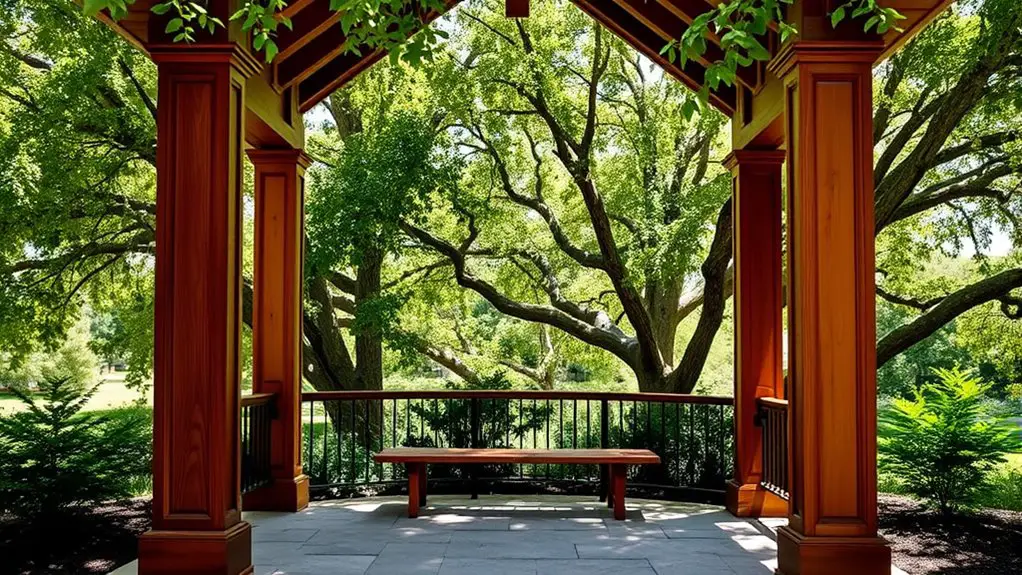When building a gazebo, it’s important to choose the right wood type for durability and maintenance. Cedar is a classic choice, offering natural decay resistance and a rich aroma. Redwood provides natural beauty and also resists decay and insects. If you’re on a budget, pressure-treated pine is an affordable long-lasting option. For a luxurious look, mahogany adds elegance with excellent stability. Composite wood is a low-maintenance alternative that combines wood aesthetics with durability. There’s much more to contemplate!
Cedar: The Classic Choice for Gazebo Construction
Cedar has long been regarded as the classic choice for gazebo construction, thanks to its remarkable properties. The cedar benefits are numerous; it’s naturally resistant to decay and insect damage, ensuring your gazebo remains beautiful for years. Its appealing aroma and rich color can enhance any outdoor space, allowing you to enjoy nature while staying connected to your environment. When it comes to cedar maintenance, the process is straightforward. Regular washing and occasional sealing can keep the wood looking fresh and vibrant, allowing you to focus on relaxation rather than repairs. Plus, cedar’s lightweight nature makes it easy to work with, giving you the freedom to create a stunning structure that complements your lifestyle. Choose cedar for timeless elegance and durability. Additionally, choosing the right wood is crucial for ensuring durability and strength, as it directly impacts the longevity of your gazebo.
Redwood: a Durable Option With Natural Resistance
When considering wood types for gazebo construction, redwood stands out as a durable option that combines beauty with natural resistance. One of the key redwood benefits is its inherent ability to resist decay and insect damage, making it a long-lasting choice for outdoor structures. Its rich, warm tones and fine grain enhance visual appeal, allowing your gazebo to blend seamlessly with nature.
In terms of redwood maintenance, it’s relatively low-effort; periodic sealing can protect its color and prolong its life. Unlike other woods, redwood doesn’t require extensive treatment, which means you can enjoy your space without the hassle of frequent upkeep. Choosing redwood empowers you to create an inviting retreat that stands strong against the elements, providing reliable protection from the elements for outdoor enjoyment.
Pressure-Treated Pine: Affordable and Long-Lasting
While redwood offers natural beauty and resistance, pressure-treated pine presents an economical alternative for gazebo construction without sacrificing durability. This wood type is treated to withstand moisture and pests, making it a long-lasting choice. When considering an affordability comparison, pressure-treated pine typically costs less than premium woods, allowing you to invest in other gazebo features.
| Feature | Pressure-Treated Pine |
|---|---|
| Cost | Economical |
| Lifespan | 15-20 years |
| Maintenance Frequency | Every 2-3 years |
| Resistance to Elements | High |
To guarantee your gazebo stays in top shape, follow these maintenance tips: apply a sealant every few years and inspect for wear. This keeps your gazebo beautiful and functional for years to come.
Mahogany: a Luxurious Look With Excellent Stability
If you’re aiming for a gazebo that blends elegance with durability, mahogany is an exceptional choice. This tropical hardwood boasts a rich, deep color and a fine grain, giving your structure a luxurious aesthetic. Mahogany’s natural resistance to warping and decay makes it incredibly stable, perfect for outdoor use. To maintain its beauty, proper mahogany care is essential; regular cleaning and sealing can protect against moisture and UV damage. You can enhance its appearance with various mahogany finishes, from clear coats to rich stains, allowing you to customize the look to suit your style. With mahogany, you’re investing not just in a gazebo but in a lasting statement of sophistication that stands the test of time.
Composite Wood: The Low-Maintenance Alternative
As you consider materials for your gazebo, composite wood stands out as a low-maintenance alternative that combines the aesthetic appeal of natural wood with the durability of synthetic materials. This innovative material is made from a blend of recycled plastics and wood fibers, offering significant sustainability benefits. You’ll enjoy the look of wood without the constant upkeep—no need for staining or sealing. When installing composite wood, guarantee proper ventilation to prevent moisture buildup and follow manufacturer guidelines for cutting and fastening. This will help extend the life of your gazebo. Embrace the freedom of spending more time enjoying your outdoor space rather than maintaining it, all while making an environmentally-friendly choice with composite wood.
Frequently Asked Questions
What Is the Average Lifespan of a Gazebo Made From These Woods?
When you think of a gazebo’s lifespan, consider it a dance with time. Factors like wood durability, maintenance, and climate can influence how long your structure lasts, typically ranging from 10 to 30 years.
How Do I Maintain Different Wood Types for My Gazebo?
To maintain different wood types for your gazebo, use proper wood treatment techniques. Regularly apply sealants, clean surfaces, and inspect for damage. These maintenance tips guarantee longevity and keep your structure beautiful, allowing you to enjoy it freely.
Can I Mix Wood Types in My Gazebo Design?
Mixing wood types can enhance design aesthetics, as studies show varied textures attract 30% more attention. Just guarantee wood compatibility to avoid issues like warping. Choose complementary colors and grains to achieve a cohesive look in your gazebo.
What Are the Environmental Impacts of Using These Wood Types?
Using various wood types can impact the environment considerably. By implementing sustainability practices and opting for eco-friendly treatments, you can minimize deforestation and chemical runoff, ensuring your gazebo project aligns with environmentally conscious values.
How Do Local Weather Conditions Affect Wood Choice for Gazebos?
Local weather conditions can make or break your gazebo’s longevity. While weather resistance matters, proper wood treatments are essential. Choosing wisely guarantees your structure withstands storms, sun, and snow, granting you the freedom to enjoy it year-round.

